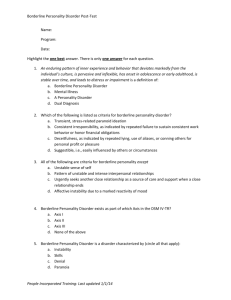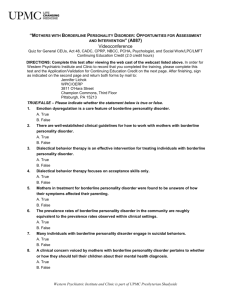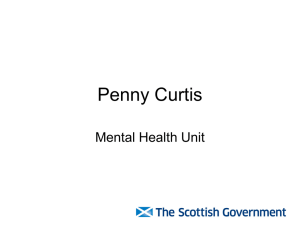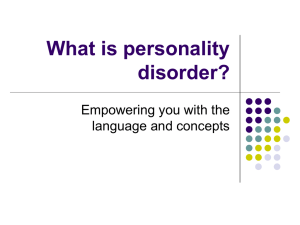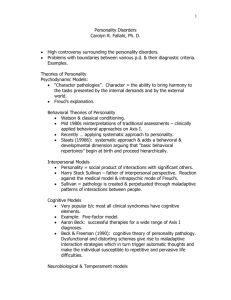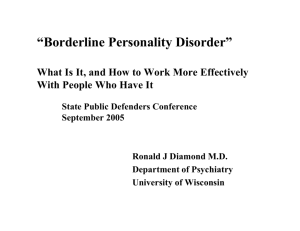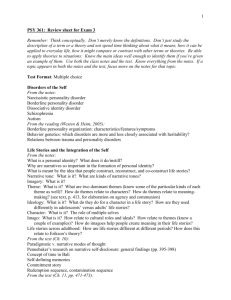Personality Disorders Continued
advertisement
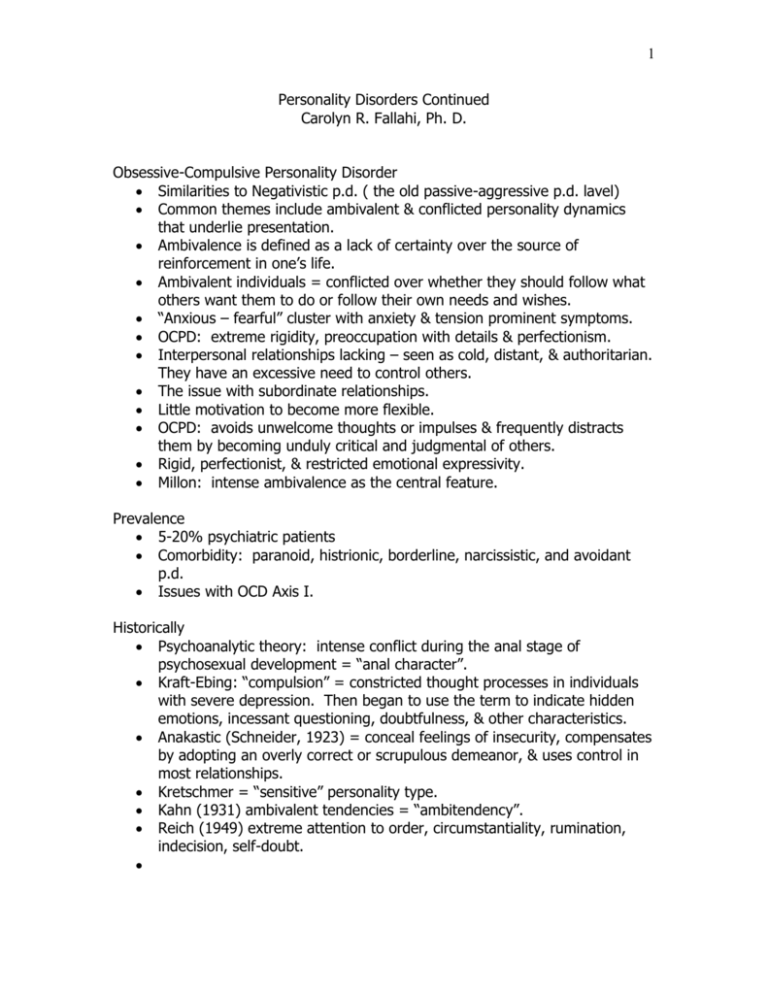
1 Personality Disorders Continued Carolyn R. Fallahi, Ph. D. Obsessive-Compulsive Personality Disorder Similarities to Negativistic p.d. ( the old passive-aggressive p.d. lavel) Common themes include ambivalent & conflicted personality dynamics that underlie presentation. Ambivalence is defined as a lack of certainty over the source of reinforcement in one’s life. Ambivalent individuals = conflicted over whether they should follow what others want them to do or follow their own needs and wishes. “Anxious – fearful” cluster with anxiety & tension prominent symptoms. OCPD: extreme rigidity, preoccupation with details & perfectionism. Interpersonal relationships lacking – seen as cold, distant, & authoritarian. They have an excessive need to control others. The issue with subordinate relationships. Little motivation to become more flexible. OCPD: avoids unwelcome thoughts or impulses & frequently distracts them by becoming unduly critical and judgmental of others. Rigid, perfectionist, & restricted emotional expressivity. Millon: intense ambivalence as the central feature. Prevalence 5-20% psychiatric patients Comorbidity: paranoid, histrionic, borderline, narcissistic, and avoidant p.d. Issues with OCD Axis I. Historically Psychoanalytic theory: intense conflict during the anal stage of psychosexual development = “anal character”. Kraft-Ebing: “compulsion” = constricted thought processes in individuals with severe depression. Then began to use the term to indicate hidden emotions, incessant questioning, doubtfulness, & other characteristics. Anakastic (Schneider, 1923) = conceal feelings of insecurity, compensates by adopting an overly correct or scrupulous demeanor, & uses control in most relationships. Kretschmer = “sensitive” personality type. Kahn (1931) ambivalent tendencies = “ambitendency”. Reich (1949) extreme attention to order, circumstantiality, rumination, indecision, self-doubt. 2 Contemporary Theories Psychoanalytic: struggles over autonomy Erikson (1950): gain autonomy over one’s self & environment. Rado (1959) mother’s demandingness & intrusiveness into child’s bowel patterns = defiance and anger. Mallinger (1984) parental rejection, authoritarian attitudes, & lack of respect for privacy. Salzman (1980) & Storr (1980) pervasive threat to security. Behaviorial: very little in the literature. Issues with the term OCPD. Turkat & Maistro (1985): learns maladaptive emotional reactions in home & emphasizes hard work & minimizes close interpersonal relationships. Cognitive Theory: Beck & Freeman (1990): OCPD clear distortions in thinking = produce rigidity & perfectionism. Cognitive disortions Musts and shoulds Interpersonal Theory: Leary (1959) OCPD style defined by actions that maintain conventionality and security. Structural Analysis of Social Behavior (Benjamin, 1974): intense fears of making a mistake / being viewed as imperfect. Endler & Edwards (1988) Pincus & Wiggins (1990) Biological perspective: limited attention Issues with anxiety. Clonginger’s (1987) neurobiological theory – novelty seeking, reward dependence, harm avoidance. Millon & Davis (1996) limbic system. Integrative Model: Millon (1996) Issues with Negativistic P.D.: stubbornness, passive resistance to fulfilling routine demands, procrastination, and inefficiency. Also sullen & irritable. Borderline Personality Disorder Essential Symptoms: Impulsivity Affective Instability Cognitive Symptoms Reliability & Validity Concerns 3 Prevalence 1-2% general population ¾ women. Why? Stone (1993) Comorbidity Axis I mood disorders. Is it a form of depression? Gunderston & Phillips (1991) Trauma research: Kolk (1987) The “borderline child” Remits by early middle age. 15 years = 75% 1/10 commits suicide. Highest risk: substance abuse + borderline Stone (1993) less likely to marry or have children Historically Problems with the term “borderline” Adolf Stern (1938) “hysteria” or “pseudo-neurotic schizophrenia” unstable personality disorder or emotionally unstable personality Contemporary Theories Biological: relatives have impulse spectrum disorders and/or affective disorders. No specific pattern of inheritance has been found. Torgersen (1984) twin studies – no MZ-DZ differences, but numbers small. Torgersen (1996) BPD large heritable component. No adoption studies. No identifiable biological markers yet to be found. Similar markers to depression, e.g. abnormal REM latency; serotonergic activity. Soft neurological signs, e.g. limbic activity issues. Siever & Davis (1991) Most likely = multiple receptors & multiple subsystems associated with each NT. Linehan (1993) “emotional vulnerability”. Psychological Factors: psychoanalytic emphasis on early experience. Large number of negative events in childhood. Borderlines also report a high frequency of childhood sexual abuse, e.g. 50-70%. Incest abuse with penetration. Physical abuse, frequency, duration, & severity. Gender issues. 4 Herman et al (1989) Zanarini et al (1989) Van der Kolk et al (1991) & self-mutilation Separation & loss b/f 16 (51%) Parental psychopathology Parental bonding issues; Gunderson et al (1980) Adler (1985) Linehan (1993) Narcissistic Personality Disorder Normal narcissism versus pathological narcissism Definition: “a pervasive pattern of grandiosity, need for admiration, & lack of empathy” Associated features: vulnerable self-esteem, sensitivity, intense reactions of humiliation, emptiness or disdain to criticism or defeat, vocational problems, feelings of shame, social withdrawal. Antisocial or borderline characteristics High achievement, promiscuity, excessive rage, suicidal behavior. NPD Clinical Features The Arrogant Narcissist The Shy Narcissist NPD with Antisocial / Borderline Features Comorbid Axis I = depression or dysthymia Suicide Affect intolerance and vulnerability Discriminating behaviors: Ronningstam & Gunderston (1990) boastful & pretentious behavior; self-centered & self-referential behavior; reactions to the envy of others. Morey (1998): inflated self-esteem & marked affective reactions to assaults of self-esteem; marked need for interpersonal control; hostility; lack of overtly self-destructive behaviors. Prevalence 2-22%. Gender differences? Late teens & early 20s; middle age very critical. Sociocultural Factors Lash (1979) Comorbidity Dramatic cluster, e.g. histrionic, borderline, paranoid, avoidant, passiveaggressive, antisocial. Bipolar patients, substance abuse, major depression, anorexia nervosa. 5 Differential Diagnosis Antisocial p.d. Borderline p.d. Histrionic p.d. Obsessive-Compulsive p.d. Paranoid p.d. Schizoid p.d. Mania & hypomania
